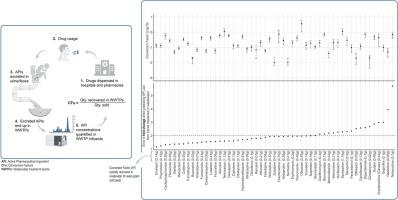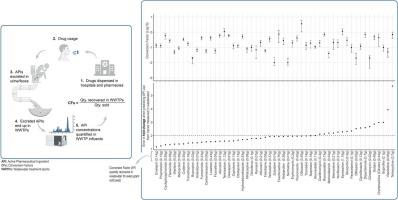Evaluating wastewater surveillance for estimating pharmaceutical use
IF 9.7
1区 环境科学与生态学
Q1 ENVIRONMENTAL SCIENCES
引用次数: 0
Abstract
Regional medicine use data is key for health management and in understanding many aspects of health, still such data is missing in many parts of the world. Here, we aimed to evaluate how well analyses of active pharmaceutical ingredients (APIs) in untreated municipal wastewater could be used to predict regional use. We studied 53 APIs measured at three wastewater treatment plants (WWTPs) in Stockholm, Sweden between 2004–2021 together with corresponding, comprehensive sales data from hospitals, pharmacies and other outlets as proxy for use. Conversion factors (CFs) representing recovered mass per gram of sold API were generated for each API using data from two WWTPs. Median absolute deviation normalized by the median (MADM) was used to evaluate variability of CFs over the years. While CFs ranged more than two orders of magnitude between different APIs, mass loads recovered in wastewater were equal or less than the estimated daily use for all except one API. The variability of CF estimates was below 100 % for 43 APIs. When evaluating the predictive performance of the derived CFs on data from the third WWTP, the typical error was <2-fold for 36 APIs (68 %). Further, our usage predictions aligned well for the majority of APIs when applied to data from independent international studies. Neither removal efficiency in WWTPs nor lipophilicity were good predictors of CFs. Our findings suggest that use of most APIs can be estimated from traces measured in wastewater with a typical error of <2-fold. This provides support for the development of wastewater surveillance for estimating medicine use to fill existing data gaps, but also suggests limitations in detecting small changes.


评价废水监测以估计药物使用情况
区域药物使用数据是卫生管理和了解卫生的许多方面的关键,但在世界许多地方仍然缺乏此类数据。在这里,我们的目的是评估如何很好地分析活性药物成分(api)在未经处理的城市废水可以用来预测区域使用。我们研究了2004-2021年间在瑞典斯德哥尔摩的三个污水处理厂(WWTPs)测量的53种api,以及来自医院、药房和其他网点的相应综合销售数据作为使用代理。利用两个污水处理厂的数据,为每个API生成代表每克售出API的回收质量的转换系数。采用中位数归一化的中位数绝对偏差(MADM)来评估多年来CFs的变异性。虽然不同原料药之间的碳当量相差超过两个数量级,但除一种原料药外,废水中回收的质量负荷均等于或低于所有原料药的估计日用量。43种原料药的CF估计变异性低于100 %。在评估基于第三次WWTP数据的衍生CFs的预测性能时,36个api的典型误差为2倍(68% %)。此外,当应用于来自独立国际研究的数据时,我们对大多数api的使用预测很好地吻合。污水处理剂的去除效率和亲脂性都不是CFs的良好预测指标。我们的研究结果表明,大多数原料药的使用可以通过废水中测量的痕量来估计,典型误差为2倍。这为废水监测的发展提供了支持,以估计药物的使用,以填补现有的数据空白,但也表明在检测微小变化方面存在局限性。
本文章由计算机程序翻译,如有差异,请以英文原文为准。
求助全文
约1分钟内获得全文
求助全文
来源期刊

Environment International
环境科学-环境科学
CiteScore
21.90
自引率
3.40%
发文量
734
审稿时长
2.8 months
期刊介绍:
Environmental Health publishes manuscripts focusing on critical aspects of environmental and occupational medicine, including studies in toxicology and epidemiology, to illuminate the human health implications of exposure to environmental hazards. The journal adopts an open-access model and practices open peer review.
It caters to scientists and practitioners across all environmental science domains, directly or indirectly impacting human health and well-being. With a commitment to enhancing the prevention of environmentally-related health risks, Environmental Health serves as a public health journal for the community and scientists engaged in matters of public health significance concerning the environment.
 求助内容:
求助内容: 应助结果提醒方式:
应助结果提醒方式:


